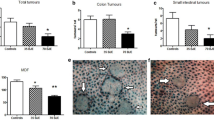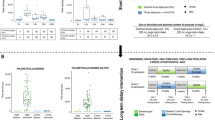Abstract
Background
Apple juice is considered to be an important component of the healthy diet, with anticancer activities in colon cancer animal models and key ingredients have numerous chemoprotective activities in human colon cells in vitro.
Aim of the study
Since only little is known on comparable activities in the human colon in vivo, here a pilot study was performed to assess related mechanisms caused by ileostomy samples from volunteers that had consumed apple juice.
Methods
Ileostomy samples were collected after intervention (0–8 h) with cloudy apple juice (1 l). They were characterized analytically for major apple polyphenols and biologically in HT29 colon cells for their potential to cause genotoxic damage, protect from the genotoxic insult by hydrogen peroxide (H2O2) and modulate the expression of GSTT2, an enzyme related to antioxidative defence against different peroxides.
Results
The analytical determination of polyphenols in the ileostomy samples revealed that the majority of the compounds were recovered in the samples collected 2 h after intervention. The comparison of genotoxic effects of samples before intervention and 2 h after intervention revealed a considerable variation of genotoxic response, but there was a trend for reduced genotoxicity in three of eight persons (P) after intervention. Samples collected at 2 h protected HT29 cells from genotoxic damage by H2O2 (for 4 of 8 persons), resulted in an increased GSTT2 expression (for 2 of 6 persons) and of GSTT2 promotor activity (2 of 6 persons).
Conclusions
The intervention with apple juice results in bioavailable concentrations of related polyphenols in the gut lumen, which could contribute to reduced genotoxicity, enhanced antigenotoxicity and favorable modulation of GSTT2 gene expression in some individuals. The pilot study for the first time used this combination of faecal biomarkers which in larger cohorts may either reveal overall significant alterations of chemoprotection or may be used to identify individuals which could particularly benefit from a personalized nutrition.





Similar content being viewed by others
References
Babbs CF (1992) Oxygen radicals in ulcerative colitis. Free Radic Biol Med 13:169–181
Balavenkatraman KK, Jandt E, Friedrich K, Kautenburger T, Pool-Zobel BL, Ostman A, Bohmer FD (2006) DEP-1 protein tyrosine phosphatase inhibits proliferation and migration of colon carcinoma cells and is upregulated by protective nutrients. Oncogene 25:6319–6324
Barth SW, Fahndrich C, Bub A, Dietrich H, Watzl B, Will F, Briviba K, Rechkemmer G (2005) Cloudy apple juice decreases DNA damage, hyperproliferation and aberrant crypt foci development in the distal colon of DMH-initiated rats. Carcinogenesis 26:1414–1421
Boyer J, Liu RH (2004) Apple phytochemicals and their health benefits. Nutr J 3:5
Branca F, Hanley AB, Pool-Zobel BL, Verhagen H (2001) Biomarkers in disease and health. Br J Nutr 86:S55–S92
Cerhan JR, Potter JD, Gilmore JME, Janney CA, Kushi LH, Lazovich D, Anderson KE, Sellers TA, Folsom AR (2004) Adherence to the AICR cancer prevention recommendations and subsequent morbidity and mortality in the Iowa Women’s Health Study Cohort. Cancer Epidemiol Biomarkers Prev 13:1114–1120
Glei M, Habermann N, Osswald K, Seidel C, Persin C, Jahreis G, Pool-Zobel BL (2005) Assessment of DNA damage and its modulation by dietary and genetic factors in smokers using the Comet assay: a biomarker model. Biomarkers 10:203–217
Glei M, Kirmse A, Habermann N, Persin C, Pool-Zobel BL (2006) Bread enriched with green coffee extract has chemoprotective and antigenotoxic activities in human cells. Nutr Cancer Int J 56:182–192
Guy CA, Hoogendoorn B, Smith SK, Coleman S, O’Donovan MC, Buckland PR (2004) Promoter polymorphisms in glutathione-S-transferase genes affect transcription. Pharmacogenetics 14:45–51
Hiratsuka A, Nishijima T, Okuda H, Ogura K, Watabe T (1997) Rat liver theta-class glutathione S-transferases T1–1 and T2-2: their chromatographic, electrophoretic, immunochemical, and functional properties. Anal Biochem 252:229–237
Hung HC, Joshipura KJ, Jiang R, Hu FB, Hunter D, Smith-Warner SA, Colditz GA, Rosner B, Spiegelman D, Willett WC (2004) Fruit and vegetable intake and risk of major chronic disease. JNCI Cancer Spectr 96:1577–1584
Hussey AJ, Hayes JD (1992) Characterization of a human class-Theta glutathione S-transferase with activity towards 1-menaphthyl sulphate. Biochem J 286(Pt 3):929–935
Kahle K, Kraus M, Scheppach W, Ackermann M, Ridder F, Richling E (2006) Studies on apple and blueberry fruit constituents: do the polyphenols reach the colon after ingestion? Mol Nutr Food Res 50:418–423
Kahle K, Kraus M, Scheppach W, Richling E (2005) Colonic availability of apple polyphenols—a study in ileostomy subjects. Mol Nutr Food Res 49:1143–1150
Kern M, Tjaden Z, Ngiewih Y, Puppel N, Will F, Dietrich H, Pahlke G, Marko D (2005) Inhibitors of the epidermal growth factor receptor in apple juice extract. Mol Nutr Food Res 49:317–328
Klenow S, Veeriah S, Knöbel Y, Pool-Zobel BL (2007) Apple polyphenols modulate the genotoxic effects of different DNA damaging compounds (in preparation)
Klinder A, Förster A, Caderni G, Femia AP, Pool-Zobel BL (2004) Fecal water genotoxicity is predictive of tumor preventive activities by inulin-like oligofructoses, probiotics (Lactobacillus rhamnosus and Bifidobacterium lactis) and their synbiotic combination. Nutr Cancer 49:144–155
Oberreuther-Moschner D, Jahreis G, Rechkemmer G, Pool-Zobel BL (2004) Dietary intervention with the probiotics Lactobacillus acidophilus 145 and Bifidobacterium longum 913 modulates DNA-damage inducing potential of human faecal water in HT29clone19A cells. Br J Nutr 91:1–9
Ordovas JM, Corella D (2004) Nutritional genomics. Annu Rev Genomics Hum Genet 5:71–118
Osswald K, Becker TW, Grimm M, Jahreis G, Pool-Zobel BL (2000) Inter- and Intra-individual variation of faecal water—genotoxicity in human colon cells. Mutation Res 472:59–70
Pfaffl MW, Horgan GW, Dempfle L (2002) Relative expression software tool (REST) for group-wise comparison and statistical analysis of relative expression results in real-time PCR. Nucleic Acids Res 30:e36
Pool-Zobel BL, Selvaraju V, Sauer J, Kautenburger T, Kiefer J, Richter KK, Soom M, Wolfl S (2005) Butyrate may enhance toxicological defence in primary, adenoma and tumor human colon cells by favourably modulating expression of glutathione S-transferases genes, an approach in nutrigenomics. Carcinogenesis 26:1064–1076
Schatzkin A, Kipnis V (2004) Could exposure assessment problems give us wrong answers to nutrition and cancer questions? J Natl Cancer Inst 96:1564–1565
Tan KL, Board PG (1996) Purification and characterization of a recombinant human Theta-class glutathione transferase (GSTT2-2). Biochem J 315(Pt 3):727–732
Terry P, Giovannucci E, Michels KB, Bergvist L, Hansen H, Holmberb L, Wolk A (2001) Fruit, vegetables, dietary fiber, and risk of colorectal cancer. J Natl Cancer Inst 93:525–533
Veeriah S, Miene C, Habermann N, Hofmann T, Klenow S, Julia S, Böhmer F, Wölfl S, Pool-Zobel BL (2007) Apple polyphenols modulate expression of selected genes related to toxicological defense and stress response in human colon adenoma cells (submitted)
Veeriah S, Kautenburger T, Habermann N, Sauer J, Dietrich H, Will F, Pool-Zobel BL (2006) Apple flavonoids inhibit growth of HT29 human colon cancer cells and modulate expression of genes involved in the biotransformation of xenobiotics. Mol Carcinog 45:164–174
Acknowledgments
The authors wish to acknowledge the excellent technical assistance of Mrs. Esther Woschee at the Institute for Nutrition, Friedrich-Schiller-University of Jena. GSTT2 reporter assays were performed by Ms. Katja Palige, and Ms. Gabriele Schulz-Raffelt. We thank Antje Volk and Gerda Dusel for taking care of the study at the Division of Gastroenterology, University of Wuerzburg and we appreciate all volunteers for their participation. This project was supported by a grant from the Bundesministerium für Bildung und Forschung (BMBF, FKZ.01EA0103), Germany.
Author information
Authors and Affiliations
Corresponding author
Rights and permissions
About this article
Cite this article
Veeriah, S., Balavenkatraman, K.K., Böhmer, F.D. et al. Intervention with cloudy apple juice results in altered biological activities of ileostomy samples collected from individual volunteers. Eur J Nutr 47, 226–234 (2008). https://doi.org/10.1007/s00394-008-0726-7
Received:
Accepted:
Published:
Issue Date:
DOI: https://doi.org/10.1007/s00394-008-0726-7




